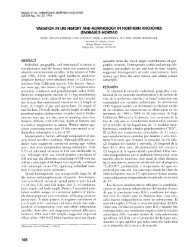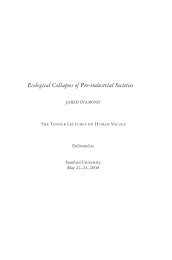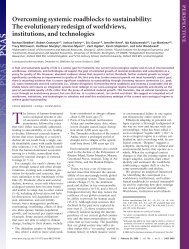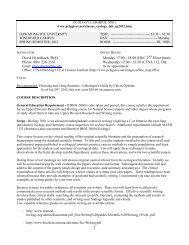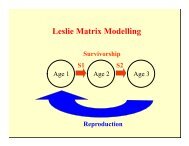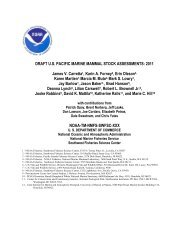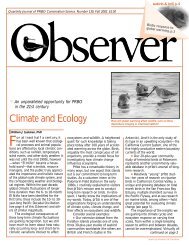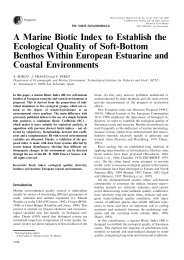A Unique Advantage for Giant Eyes in Giant Squid - Duke Biology ...
A Unique Advantage for Giant Eyes in Giant Squid - Duke Biology ...
A Unique Advantage for Giant Eyes in Giant Squid - Duke Biology ...
Create successful ePaper yourself
Turn your PDF publications into a flip-book with our unique Google optimized e-Paper software.
Current <strong>Biology</strong>, Volume Supplemental In<strong>for</strong>mationA nique dvantage <strong>for</strong> iant yes <strong>in</strong> iant quidDan-E. Nilsson, Eric J. Warrant, Sönke Johnsen, Roger Hanlon, Nadav ShasharSupplemental TheoryDiscrim<strong>in</strong>ation criteria Detection of a target aga<strong>in</strong>st a background requires discrim<strong>in</strong>ation ofsignals from visual channels sampl<strong>in</strong>g light from the target and the background respectively. Weassume that the channels be<strong>in</strong>g compared have identical properties. A target channel detects amean of N T photons per <strong>in</strong>tegration time, and the correspond<strong>in</strong>g mean count <strong>for</strong> a backgroundchannel is N B . The photon counts are sums of real photons and <strong>in</strong>tr<strong>in</strong>sic noise. We follow Land[24] and assume Gaussian distribution of photon samples. Discrim<strong>in</strong>ation between the signals <strong>in</strong>the two channels is possible when the difference is greater than or equal to a reliability constant Rtimes the standard deviation of the difference (which is the square root of the sum of the twomeans; see Land [24]: N T− N B≥ R N T+ N B. The discrim<strong>in</strong>ation threshold is then given by:€N T− N B= R N T+ N BEq. 1€Variables and constants are def<strong>in</strong>ed <strong>in</strong> the Table on page 5. For confidence levels and values of Rsee the Table on page 6.Case 1: Detection of a po<strong>in</strong>t-source on a black target We assume a pair of visual channelsoptimally suited to discrim<strong>in</strong>ate a po<strong>in</strong>t source aga<strong>in</strong>st a dimmer background. A target channel isaimed at the biolum<strong>in</strong>escent po<strong>in</strong>t source, and its signal is compared to that of a channel aimed atthe background next to the po<strong>in</strong>t source (Fig. 2A). The target channel is assumed to receive alllight that enters the eye from the biolum<strong>in</strong>escent po<strong>in</strong>t source. For both channels, the targetblocks background space-light from beh<strong>in</strong>d the target, but new space-light is scattered <strong>in</strong>to thel<strong>in</strong>e of sight between the target and the observer. The target channel will receive an average ofN bio photons per <strong>in</strong>tegration time from the po<strong>in</strong>t source and N black photons scattered <strong>in</strong> along thel<strong>in</strong>e of sight, whereas the background channel only receives N black photons from the l<strong>in</strong>e of sight.Each channel also generates an average of X ch false photons per <strong>in</strong>tegration time. The totalaverage signal <strong>in</strong> the target channel will thus be N T= N bio+ N black+ X chand <strong>in</strong> the backgroundchannel, N B= N black+ X ch. Insert<strong>in</strong>g this <strong>in</strong>to Eq. 1 gives:N bio= R N bio+ 2N black+ 2X ch. €Eq. 2€€



